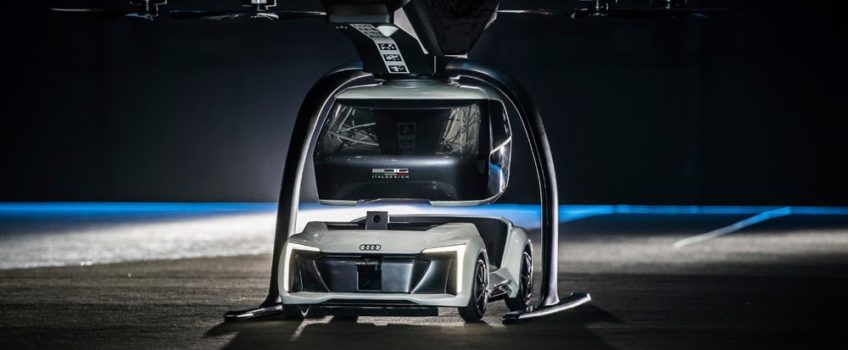
Credit: New Atlas
We can never get tired of reading and writing about engineering developments, emerging technologies and the flying taxi. This year has already seen a few interesting concepts from Uber signing with NASA to the CityHawk and Pal-V. And now it is time for Audi to step up to the plate.
The German automaker is living up to their name with the new Pop.Up Next, a hybrid quadcopter and compact two-seater electric vehicle. This is certainly an ambitious attempt but one that seems well worth it considering their partnership with Italdesign and Airbus.
Audi’s Pop.Up Next Flying Taxi Drone
Combining the expertise from Audi and their collaboration with subsidiaries Italdesign and Airbus, this pioneering transportation solution may not seem that far-fetched. In fact, the concept was first seen at the 2017 Geneva Motor Show and again at this year’s event.
The full-size part-drone, part-self-driving electric car prototype was not only eye-catching but also incredibly intriguing and audacious. The flying taxi concept was a massive hit at the Geneva show where the large quadcopter hovering over a compact two-seater vehicle mesmerised attendees.
Fact is, Audi’s flying taxi concept actually consists of three different parts that don’t yet really exist. Starting with an electric sled that produces 60 kW (80 HP) that connects to the cabin of a zero-emission self-driving two-seater car. Now comes the interesting part. Hypothetically speaking, if commuters get stuck in heavy traffic, they simply use the Pop.Up Next mobile app to request one of the air modules to fetch them. With us so far? So, the air module attaches to the passenger pod and lifts it from the ground and flies passengers to their destination. Ultimately, the self-driving two seater turns into a flying taxi.
This module or aircraft, if you will, takes off from a nearby charging station and proceeds to the vehicle’s location. From there it latches onto its roof and seamlessly flies away. The passenger cabin can also detach from the electric sled where the quadcopter carries it for more than 50km (31mi). The 70 kWh battery pack and lightweight design make this kind of range possible. Imagine calling Uber and it turns out to be an autonomous, giant quadcopter capable of transporting you and your vehicle. Can you say science-fiction? Take a look at the concept video below:
Flying Taxi Predictions
The German automaker stated earlier in 2018 that they don’t expect the Pop.Up Next flying taxi system to take to the skies for at least 7-10 years. And while Audi has made massive strides in this segment, there are still big technological and regulatory issues to iron out. Companies including Uber, Pal-V, Aston Martin, Daimler and Bell all face the same obstacles and something that will be resolved before long. At least that’s what we’re hoping for!
Audi continues to explore possibilities within the realm of end-to-end services. In fact, at Drone Week in Amsterdam, Audi performed demo flights using a 1:4 scale model of the Pop.Up Next concept. The miniature flying taxi performed in fully autonomous mode inside a closed arena.
The test flight entailed the passenger cabin riding on the sled in a simulated trip to meet up with the air module. From there, the air module carries the cabin for 80 m (260 ft) and places it onto another ground module to continue on its journey. They developed the model to demonstrate the value of the modular design of Pop.Up Next as well as the docking capabilities of the various components.
Audi will also conduct tests in South America where customers can experience helicopter flights combined with Audi ground transport services. Perhaps we will see a full-sized working concept and who knows, maybe this is the future of transportation.
Follow our weekly blogs if you would like to keep up-to-date on emerging technologies, engineering and manufacturing. We work with a wide range industries including automotive, aerospace, defence and rail among others. Please get in touch with our team if you need help with your fabrication project.
One comment
Leave a Comments Cancel Reply
This site uses Akismet to reduce spam. Learn how your comment data is processed.


 Mail:
Mail: 




[…] Recommended: ‘Audi Combines Electric Car With Flying Taxi Concept’ […]